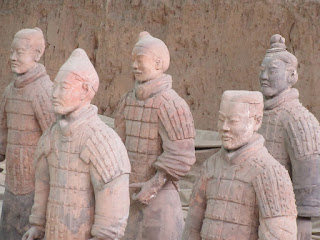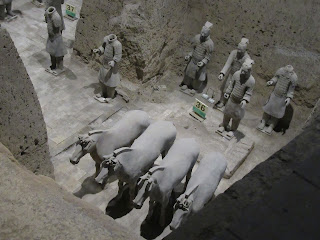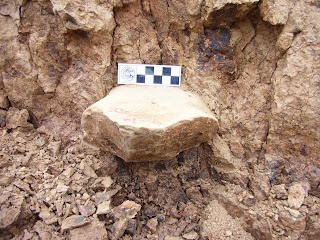 |
Terracotta Warriors
Photo (c) Clare Golden |
In 1974, a farmer digging a well
in Lintong County, east of Xi’an in Shaanxi Province, unexpectedly stumbled
upon a terracotta warrior pit adjoining the Mausoleum of Qin Shi huang.
Brightly painted and buried in battle formation, the life-sized army would
protect for eternity one of the most influential leaders of all time - China’s
First Emperor, Qin Shi Huang.
The exhibition, China’s First Emperor and the Terracotta
Warriors, currently running at World Museum in Liverpool features one hundred and twenty-five
cultural artefacts. The exhibits include life-sized terracotta figures in
various postures and with different facial expressions. It also includes
exquisite gold, silver, bronze, ceramic, and jade objects. Incidentally,
Liverpool has one of the oldest Chinese communities in Europe. Excavations over
the last 40 years have revealed 2,000 sculptures. However, it is estimated that
there are some 8,000 warriors and horses in total.
 |
Terracotta Warriors
Photo: Clare Golden |
The making of the
Terracotta Warriors
Each life-size Terracotta Warrior
weighed between 110 and 300 kilos and measured about 1.8 metres in height. They
are equipped with lethal bronze weapons. Buried in three pits, they include
infantry, cavalry, charioteers, archers, and crossbowmen. So far, more than
40,000 bronze weapons have been found including swords, lances, halberds,
spears, dagger-axes, hooks, arrows, crossbow triggers and ceremonial weapons.
The Terracotta Warriors bear the
stamps or carved names of their makers. Lin and Li, in their book to accompany
the Liverpool Exhibition, state:
“Each Terracotta Warrior was
built from the ground upwards in a succession of body parts made from thick
coils of clay, while its head was made and fired separately, with soft clay
used to fill any gaps between the head and body. A considerable amount of
sculptural detail, including robes, scale armour, hair and facial features was
then added by hand.”
After firing, each Terracotta
Warrior was covered in lacquer before various bright pigments were applied.
Warring States and
the Rise of the Qin
During the Spring and Autumn
Period (770-475 BC), the Zhou territory was formed of 148 small states that
were all related to the Zhou royal family. Wars continuously reduced the number
of states, and ultimately seven strong states emerged during the late Warring
States Period, each competing to unify China: the Han, Zhao, Wei, Chu, Yan, Qi,
and Qin.
States’ armies were small in
scale at this time, with no more than 30,000 men, and battles usually lasted
less than a day. During the later
Warring States Period (475-221 BC), the scale of battles expanded, and military
techniques improved. States erected defensive walls along state boundaries.
Northern states, such as the Zhao, Yan, and Qin, built walls right along their
state borders to defend against invasion by northern nomads. Following the unification of China in 221 BC, the First Emperor connected these walls, to form the original ‘Great Wall’.
The Warring States Period was age
of chaos and bloody battles, but it was also a golden age of Chinese
philosophy. The Legalist philosophy adopted by the Qin pronounced that human
nature was inherently selfish and more disposed to do bad than good, and that
the only way to preserve the social order was to impose discipline and strict
law enforcement. The ensuing reform of the legal system conceived by the Qin
statesman, Shang Yang (c 385-338 BC), which rewarded those who behaved well but
punished wrong doers, laid the foundations for the Qin unification of China.
However, the concentration of power also accelerated the collapse of the Empire
after the death of the First Emperor.
 |
Terracotta Warriors with horses
Photo: Clare Golden |
By 230 BC, the Qin’s military
campaign and drive to unification was unstoppable. By 221 BC, the remaining
kingdoms – Han, Zhao, Wei, Yan, Chu, and Qi – had each been conquered and
assimilated. The entire territory of what was then China had been united.
Immediately after the unification of China in
221 BC, Ying Zheng proclaimed himself Qin Shi Huang.
The Origins of Ying
Zheng
In 246 BC, King Zhuangxiang died,
and Ying Zheng became King of the Qin at just 13 years of age. He too appointed Lu Buwei as his chancellor
but given the King’s youth and inexperience, the cunning ex-merchant effectively
controlled the kingdom of Qin. When he was aged 22, Ying Zheng finally banished
Lu Buwei and replaced him with another advisor, Li Si.
Before unification only
aristocrats could hold rank and power, but the Qin created a system of ranks
and grades that rewarded all men for success in battle. Success was measured by
the number of decapitated heads of enemies taken; one head was rewarded with
one rank, two heads with two ranks etc, the officers were given rank depending
on the number of heads their subordinates removed.
Standardisation and
Innovations
Together with the Great Wall, the
road network, the Lingqu canal and the famed mausoleum, the building of the
Emperor’s palaces was one of the largest construction projects in the Empire.
After several relocations, the Qin capital was finally moved to Xianyang, about
12 miles north-west of present day Xi’an, in 350 BC by Duke Xiao.
To control the rich and powerful
families of his conquered kingdoms, the Emperor ordered 120,000 influential
families to relocate to Xianyang city. He also ordered the families to recreate
the famous halls and palaces of their conquered kingdoms along the north bank
of the Wei River. The buildings were linked to one another so that the First
Emperor might walk among them and contemplate his many triumphs.
The Death of the
Emperor
Between 220 and 210 BC, Qin Shi
Huang made five inspection tours of his realm, and had seven inscribed stelae
(stone tablets) erected on sacred mountains. The stelae inscription texts are
valuable sources of information about Qin literature and ritual. During his
third tour in 218 BC, the First Emperor survived an assassination attempt in
Wuyang (in present day Guangdong Province). The First Emperor conducted his
fifth tour in 210 BC, again to the east, but died on the return journey, aged
just 49.
Qin Shi Huang was fearful of death
and searched for an elixir that would make him immortal. At the same time, he
commissioned the building of his mausoleum at the foot of Li Mountain, 35
kilometres from the modern city of Xi’an. He ordered the palace alchemists to
make potions which contained mercury in the hope it would extend his life,
little realising that mercury is poisonous.
 |
Terracotta Warrior
Photo: Clare Golden |
The Tomb Complex of
the First Emperor of China
In death, as in life, Qin Shi Huang had
everything to continue his rule: a Terracotta Army to protect him; bronze
chariots for travelling; terracotta acrobats for his entertainment; an arsenal
storing stone armour, stables full of horse skeletons, and his concubines
buried alive with him.
Those who accompanied the Emperor
on his final inspection tour, particularly Zhao Gao and Li Si, concealed the
news of his death and instead returned to Xianyang with the intention of naming
a new emperor of their choosing. They had the Emperor’s corpse concealed in the
imperial chariot, and to mask the putrid stench in the summer heat they loaded
a cart with salted fish to accompany the chariot back to the capital.
The First Emperor had many
concubines and fathered many sons and daughters. Fu Su, his eldest son and
likely heir, had displeased the Emperor by criticising his father’s book
burning and had been sent away to the northern border. However, the Emperor had
given orders suggesting that Fu Su should become his successor.
Zhao Gao ignored these wishes and
through political manipulation engineered the accession of Hu Hai, a younger
son of the Emperor with whom he had become friendly. Fu Su was forced to commit
suicide and Zhao Gao also contrived the death of General Meng Tian, known for
his military abilities and the construction of the Great Wall. Following the
suicide of the Second Emperor, Zhao Gao placed his own nominee, Ziying, on the
throne.
The Qin Dynasty was short-lived.
After Qin Shi Huang died it ended abruptly due to the influence of Zhao Gao and
the weakness of the Second Emperor. Within five years of the First Emperor’s
death, peasant rebels had stormed Xianyang and one of the leaders, Liu Bang,
had taken the throne and established the Han Dynasty (206 BC – AD 220).
The Han Dynasty lasted for more
than 400 years and rivalled the almost contemporary but smaller Roman Empire in
the west. A census in AD 2 records almost 60 million people in the Chinese
Empire.
The Qin and Han
Legacies
Modern China retains many of the
vestiges of both the Qin Empire and its longer-lived successor, the Han
Dynasty. This is evident in the physical structures that remain but also in the
beliefs and cultural practices of the Chinese people. Much of Chinese culture
can be traced back to the Han Dynasty. It was an era of peace and prosperity
that allowed China to expand to become a major world power.
The Han love of jade also
continues. The Qin influence is probably best evidenced by the physical
structures that remain, The Great Wall of China, the road network, the Lingqu
Canal, and of course the First Emperor’s tomb are all prominent relic of the
Qin’s extreme ambition and power.
James CS Lin and
Xiuzhen Li – Edited by Karen Miller (2018) which accompanies the exhibition at the World Museum, Liverpool which runs until 28th October 2018.

































